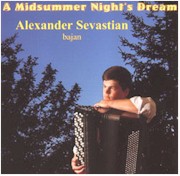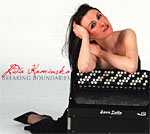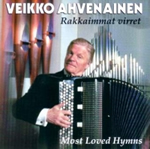The Free-Reed Review
Critiques of Compact Discs, Books and Music Scores
CD Review: Three New Classical Accordion Releases

Alexander Sevastian:
A Midsummer Night's Dream
Alexander Sevastian: bayan (Jupiter model 310, built by Jupiter Bayan Ltd., Moscow.
Reeds by Alexej Arapov)
Total time: 64:03
Label: self-produced
released: 2005
|
Program:
- J. S. Bach (1685 - 1750) Toccata and Fugue in D minor (BWV 565)
- D. Scarlatti (1685 - 1757) Sonata in D minor (K9 L413)
- D. Scarlatti (1685 - 1757) Sonata in D Major (K96 L465)
- D. Scarlatti (1685 - 1757) Sonata in E Major (K380 L23)
- F. Schubert (1797 - 1828) Moment Musicale in F minor
- S. Goubaidulina (1931) De Profundis
- A. Repnikov (1932) Capriccio
- S. Berinski (1946 - 1998) Thus Spoke Zarathustra (4 movements)
- Cadenza
- Dance
- Chorale
- Lullaby
- Ye. Derbenko (1949) Paraphrase on the theme of Rossini's 'Tarantella'
- A. Khachaturian (1903-1978) Toccata
- F. Mendelssohn (1809-1847) Scherzo from a 'Midsummer Night's Dream' Suite
- S. Rachmaninov (1873-1943) Scherzo
|

Lidia Kaminska:
Breaking Boundaries
Lidia Kaminska: accordion
(Zero Sette B32 C 64 T58 Special N, built in 1995)
Ian Flatt, cello
James hall, flute
Beau Bedsoe, guitar,
Jeff Harshbarger, double bass
Pat Alonzo Conway, dumbek
Fernando Achucarro, cajon
Bill Solomon, percussion
Scotty McBee, drum set
Total time: 70:36
Label: Tzigane
Released: 2005
|
Program:
- J.S. Bach (1685-1750) Prelude and fugue in B flat Major from The Well Tempered Clavier, Book One, BWV 866
- Jaroslaw Bester (1976- ) The Amorous Dance of the Orchid
- Tomás Gubitsch (1957- ) Villa Luro
- Anibal Troilo (1914-1975) La Trampera
- Astor Piazzolla (1921- 1992) La Grand Tango
- Franck Angelis (1962- ) Romance
- A. Repnikov (1932) Capriccio
- J.S. Bach (1685-1750) Sonata for flute and keyboard in G minor, BWV 1020
- Allegro
- Adagio
- Domenico Scarlatti (1685-1757) Sonata for Keyboard in E Major, K. 162
- Torbjörn Lundquist (1966- ) Duell
- Brad Cox (1967- ) Schenker's Last Stand
- Astor Piazzolla (1921-1992) Coral
|

Veikko Ahvenainen:
Most Loved Hymns
Veikko Ahvenainen: bayan
(custom-built by Yuri Volkovich in 1981)
Total time: 50:34
Label: Accordia ACD 233
Released: 2004
|
Program:
- Beautiful Savior
- For the Glory of God
- Abide With Me
- I Give Myself Into Your Care
- A Path Leads Through A Herb Garden
- Thank You, Father
- Day By Day
- Lord, As A Pilgrim On Earth I Remain
- I Lift My Eyes Up to Heaven
- How Marvellous God's Greatness
- Bless Us And Protect Us
- Near My God To Thee
|
Review by Henry Doktorski:
Rarely do I receive such a treat in the mail: three superb CDs by giants of the classical free-bass left hand, five-row chromatic right hand button-accordion, or bayan. Certainly if I was stranded on a desert island in the Pacific, I would hope
that I might have these three discs with me and access to a CD player!
Although still a young man, not yet 30 years old, Alexander Sevastian is making a significant contribution to the classical accordion world. Born in Minks, Belarus, he studied at the Glinka Music College in Minsk, and then at the Gnessin Academy of Music in Moscow under Professor Friedrich Lips. He was the winner of the "ATG Anthony Galla-Rini International Competition for Classical Accordion" in 2001 at San Antonio, Texas. In 2002 Sevastian emigrated to Toronto, Cananda, and since 2002 he has been the accordionist for the internationally-recognized chamber music ensemble Quartetto Gelato.
Sevastian's debut CD features a balanced program of classics, including a substantial serving of original 20th-century works for the bayan by Russian composers such as Gubaidulina, Repnikov, Berinski and Derbenko. Sevastian's playing
is superb. Such a wonderful performer.
Polish accordionist Lidia Kaminska (even younger than Sevastian) received her Masters Degree in Accordion Performance in 1999 at the prestigious Chopin Academy of Music in Warsaw under the tutelage of Professor Wlodzimierz Lech Puchnowski. In 2002 she received her Doctor of Musical Arts degree in Accordion Performance at the
University of Missouri, Kansas City, under Professor Joan Cochran Sommers. That same year she won two ATG competitions: International Competition for Virtuoso Entertainment Music and International Competition for Classical Accordion.
Kaminska's CD (also a debut CD) features the accordion as a solo instrument and also in combination with other instruments. Some of the pieces, such as Jaroslaw Bester's "The Amorous Dance of the Orchid" for accordion, double bass and dumbek (a type of drum), and Tomás Gubitsch's "Villa Luro" for accordion and guitar, have a popular or jazzy dance-music feel. Others, like the Bach and Scarlatti, have a more-formal structure and style. I must draw particular attention to Kaminska's performance of Piazzolla's "Le Grand Tango" for cello and accordion. This piece, originally written for cello and piano, is not easy to perform successfully on the accordion, as the piano is a percussive instrument and the accordion is a sustaining instrument. I was pleasantly surprised to hear how nicely the piano part sounds in Kaminska's capable hands. Very nice.
Finnish-born Veikko Ahvenainen (b. 1929) has played accordion professionally probably longer than the total years added together of the lifespans of Sevastian AND Kaminska! Ahvenainen started his solo concert career in 1950 and has played with many symphony orchestras in world-famous concert halls, including the Tchaikovsky Concert Hall in Moscow, where he was the first accordion artist from the Western world allowed to perform there. He has performed on some fifty records and CDs.
Ahvenainen tells me this is one of his most popular CDs, and I can understand why. The arrangments, all I assume by the performer, are masterfully written in a style perfectly emulating the contrapuntal style of much sacred music. Ahvenainen captures the spirit of each hymn with a beautiful legato touch worthy of any pipe organ.
All in all, I cannot imagine any classical accordion lover who would not want to have these wonderful CDs in their libraries.


